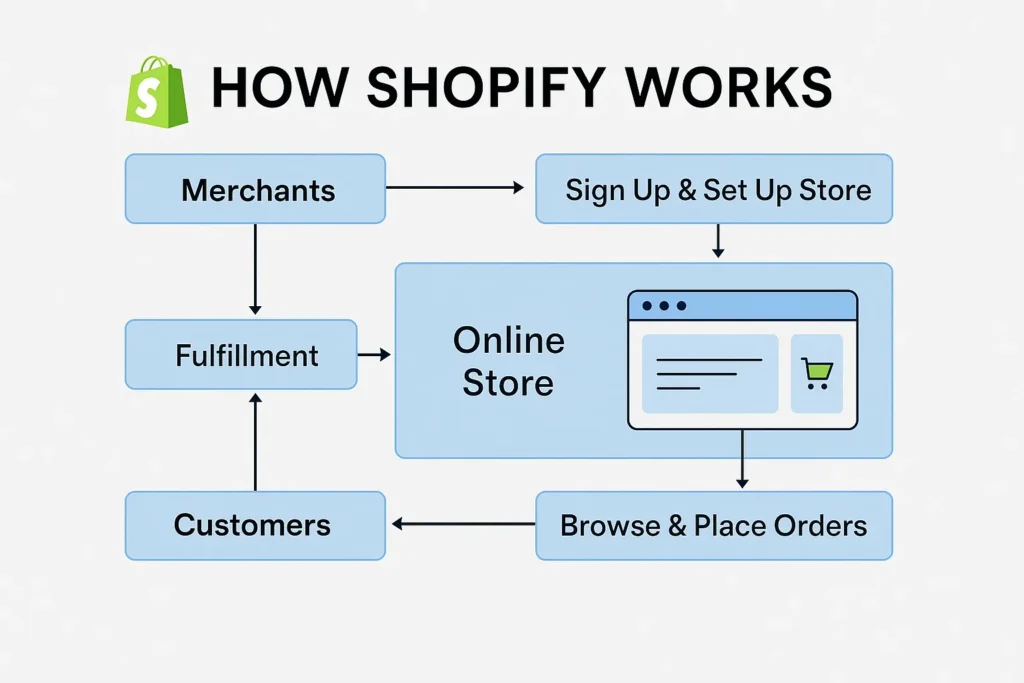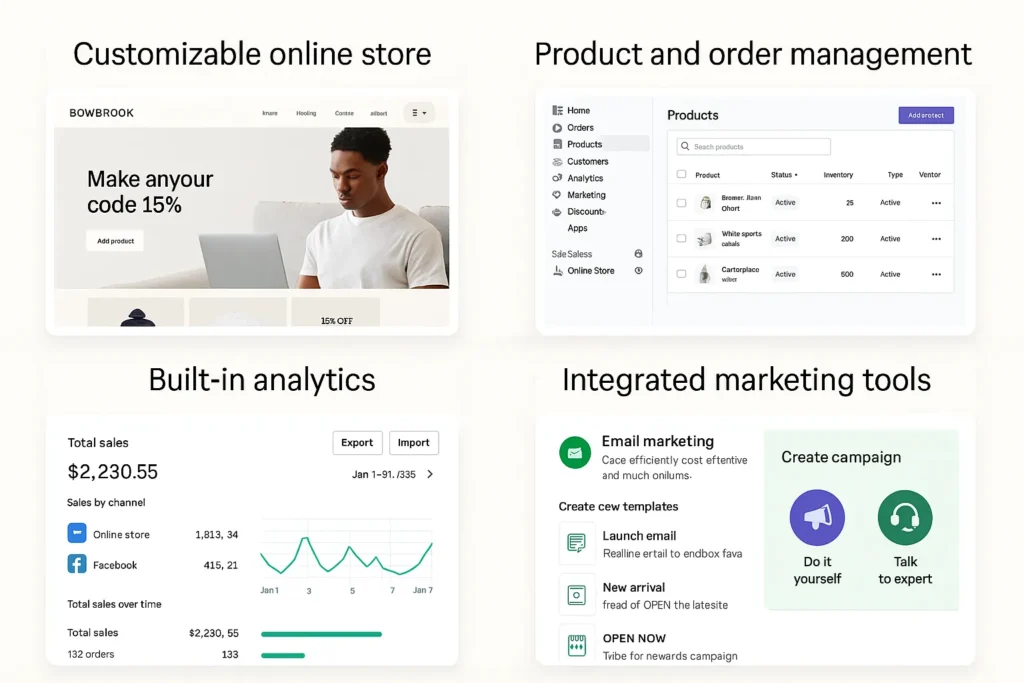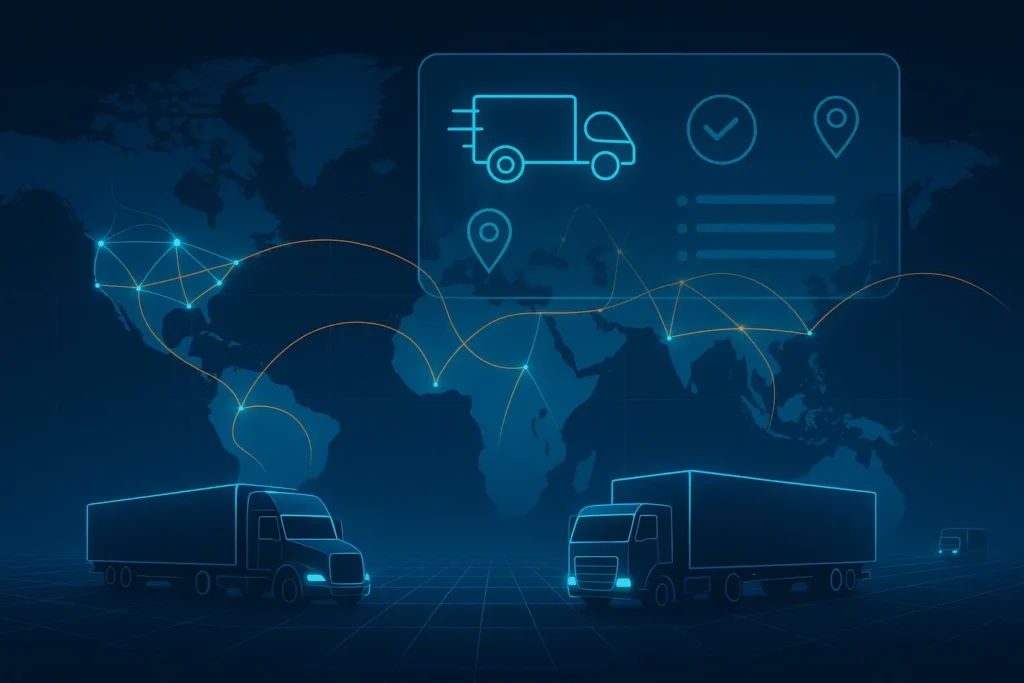Imagine you want to start selling something online — handmade candles, digital courses, fitness gear, or even print-on-demand merchandise — but you don’t know coding, don’t want to hire a developer, and want to launch this week, not months later.
That’s where Shopify steps in.
Founded in 2006 as a small attempt to build a simple online snowboard shop, Shopify has grown into the world’s #1 e-commerce platform, powering over 2.2 million active stores in 2025 across 175+ countries. From solo entrepreneurs to Fortune 500 brands, Shopify has become the backbone of global online retail.
Shopify’s impact today is massive — it has enabled $900+ billion in total sales, offers 8,000+ apps for customization, and gives businesses everything they need to launch, scale, and automate their online stores.
What is Shopify? The Simple Explanation
Shopify is a cloud-based e-commerce platform that allows anyone to create, manage, and grow an online store without technical skills. You can sell physical products, digital goods, subscriptions, services, or even run a POS-enabled retail store — all from one dashboard.
The Core Problem Shopify Solves
Before Shopify, launching an online store meant hiring developers, handling hosting, configuring payment gateways, and managing security. Shopify removes all this complexity with an all-in-one solution.
Target Users & Use Cases
Shopify is used by:
- Entrepreneurs launching a new online store
- D2C brands scaling globally
- Wholesale & dropshipping sellers
- Print-on-demand businesses
- Influencers & creators selling merch
- Service providers needing booking/checkout
- Enterprise brands (Shopify Plus)
Market Position (Latest 2025 Stats)
- 2.2M+ active stores globally
- $900B+ cumulative GMV processed
- 29% share of US e-commerce platforms market
- Used in 175+ countries
- Shopify Plus used by 18,000+ enterprise brands
Why Shopify Became So Successful
Because it offers:
- Simplicity → launch in minutes
- Extreme scalability → from 1 product to millions
- Massive app ecosystem → 8,000+ plugins
- Reliable infrastructure → 99.99% uptime
- Built-in marketing tools & AI features
- Seamless payments & global currencies
- Customization without heavy coding
Read more: Complete Guide to Starting an E-commerce App Business
How Does Shopify Work? Step-by-Step Breakdown
Shopify works as a fully hosted e-commerce platform where you can build a store, upload products, accept payments, manage orders, and grow your business — all from one place. Here’s the simple breakdown:
FOR USERS (Store Owners / Sellers)
1. Account Creation
- Go to Shopify.com
- Enter email → create password → choose store name
- Answer a few onboarding questions
- Access your dashboard instantly — no installation required
2. Main Features Walkthrough
- Dashboard: Central hub for products, orders, analytics, and marketing
- Themes: 180+ free/paid responsive templates
- Product Management: Add pricing, inventory, variants, media
- Payments: Activate Shopify Payments or connect 100+ gateways
- Shipping Setup: Select carriers, print labels, set zones
- Marketing Tools: Email automation, discounts, SEO tools, social selling
- App Store: Extend features with 8,000+ plugins
- Analytics: Real-time reports, conversion tracking, AOV insights
3. Typical User Journey (Example)
Sam, a boutique owner, signs up → selects a theme → uploads 10 products → connects Shopify Payments → installs a shipping app → launches her store in 2 hours → starts accepting orders the same day.
4. Key Functionalities Explained
- Storefront builder: Drag-and-drop customization
- Checkout system: Optimized for conversions
- Inventory engine: Auto stock adjustment
- Order management: Track, fulfill, notify
- Marketing suite: SEO, discounts, email, social integration
- POS: For physical stores
FOR SERVICE PROVIDERS (If Applicable)
Shopify App Developers
- Onboard via Shopify Partners Program
- Build apps using API + dev tools
- Earn through paid apps or subscriptions
- Shopify takes 0% commission up to $1M, then 15% afterward
Shopify Experts / Agencies
- Apply to Shopify Experts Marketplace
- Offer services like design, marketing, development
- Earn through project-based work, no commissions taken
Shopify Merchants’ Suppliers
- Print-on-demand (e.g., Printful, Printify)
- Dropshipping suppliers (e.g., DSers, Spocket)
- Integration through API or apps
TECHNICAL OVERVIEW (Simple Explanation)
Basic Architecture
Shopify uses a multi-tenant cloud architecture, meaning thousands of stores share fast, secure Shopify servers — no hosting required.
Key Technologies Used (Simplified)
- Backend: Ruby on Rails
- Frontend: Liquid templating + React for admin
- Databases: MySQL, Redis
- Hosting: Shopify’s global cloud infrastructure
- AI Tools: Shopify Magic (product writing, insights)
- APIs: REST + GraphQL
How It All Works Together
- Storefront loads from Shopify’s global CDN
- User browses → adds product → checkout
- Shopify processes payment
- Seller fulfills order from dashboard
- Shopify handles security, hosting, scaling

Shopify’s Business Model Explained
Shopify operates on a hybrid subscription + transaction revenue model, making it one of the most profitable SaaS companies in the world. Here’s the 2025 breakdown:
1. How Shopify Makes Money (All Revenue Streams)
a) Subscription Plans (Main Income Source)
Merchants pay monthly or yearly fees:
- Basic: $39/month
- Shopify: $105/month
- Advanced: $399/month
- Shopify Plus (Enterprise): Starts at $2,300/month
- Starter Plan: $5/month (for link-in-bio sellers)
b) Transaction Fees
If merchants don’t use Shopify Payments, Shopify charges:
- 2.0% – 0.5% per transaction depending on the plan.
c) Shopify Payments Revenue
Even with its own payment gateway, Shopify earns:
- Processing fees (2.4%–2.9% + 30¢)
- Currency conversion fees
- Chargeback fees
d) App Store Revenue
Shopify earns from:
- Paid apps
- Subscription-based apps
- One-time purchases
(Developers pay 0% commission up to $1M revenue, then 15%.)
e) Themes Marketplace
Shopify earns from:
- Paid theme sales
(Developers split revenue with Shopify.)
f) POS (Point of Sale) & Hardware
Revenue from selling:
- POS terminals
- Card readers
- Retail kits
- In-store processing fees
g) Shopify Capital
Shopify gives loans/cash advances and earns through repayment fees.
h) Shopify Fulfillment Network (SFN)
Revenue from storage, picking, packing, and delivery services.
i) Shopify Ads (New 2025 Revenue Stream)
Search and recommendation placements inside the Shopify ecosystem.
2. Pricing Structure (2025 Updated)
- Plans start from $5 and go up to $2,300+
- Transaction reductions on higher tiers
- Discounted yearly pricing available
- Shopify Plus charges GMV-based variable fees
3. Commission / Fee Breakdown
| Plan Type | Monthly Fee | Transaction Fee (Without Shopify Payments) | Card Processing Fee (US) |
| Starter | $5 | 5% | 5% |
| Basic | $39 | 2.0% | 2.9% + 30¢ |
| Shopify | $105 | 1.0% | 2.7% + 30¢ |
| Advanced | $399 | 0.5% | 2.4% + 30¢ |
| Shopify Plus | $2,300+ | 0.15% (approx) | Negotiated rates |
4. Market Size & Growth Stats (2025)
- Shopify ecosystem valued at $200B+
- Contributes to 5.4% of all U.S. e-commerce
- Expected to cross $1.2 trillion GMV by 2027
- 3rd largest e-commerce platform globally
- Shopify Plus merchants generate more than $150B yearly
5. Profit Margins Insights
- High-margin SaaS subscription revenue
- Recurring payments from millions of stores
- Low churn rate among enterprise clients
- Strong revenue from cross-selling (apps, payments)
| Revenue Stream | Description | Est. Contribution (2025) |
| Subscription Plans | Monthly recurring charges | 35% |
| Shopify Payments | Payment processing & fees | 45% |
| App Store | Paid apps & subscriptions | 10% |
| Themes Marketplace | Theme sales commissions | 3% |
| POS & Hardware | Retail products | 4% |
| Shopify Capital | Loan repayment fees | 2% |
| Fulfillment Network | Logistics & delivery | 1% |
Key Features That Make Shopify Successful
Shopify’s massive global adoption isn’t luck — it’s because the platform offers a combination of usability, flexibility, and innovative technology that few competitors can match. Here are the top 10 features that power Shopify’s success in 2025.
1. Drag-and-Drop Store Builder
Why it matters: Anyone can build a professional store without coding.
Benefit: Faster launch time, less dependency on developers.
Tech behind it: Liquid templates + React-based editor.
2. Shopify Payments
Why it matters: Instant setup, no third-party integration required.
Benefit: Low friction checkout + better conversion rates.
Tech: PCI Level-1 compliant payment processing.
3. 8,000+ App Integrations
Why it matters: Add any feature — upsells, subscriptions, loyalty, AI chatbots.
Benefit: Full customization of your business model.
Tech: REST & GraphQL APIs enabling deep app connectivity.
4. Mobile-Optimized Themes
Why it matters: 75% of Shopify traffic comes from mobile (2025 data).
Benefit: Faster loading + higher mobile conversion.
Tech: Responsive, lightweight Liquid-based themes.
5. AI-Powered Shopify Magic
Why it matters: AI helps with product descriptions, marketing content, and insights.
Benefit: Saves time and boosts sales.
Tech: Proprietary Shopify AI + predictive analytics.
6. Multi-Channel Selling
Sell on:
- TikTok
- Amazon
- Walmart
- Google Shopping
Benefit: Reach customers everywhere.
Tech: Pre-built channel integrations via APIs.
7. Shopify POS (Point of Sale)
Why it matters: Combine offline + online selling.
Benefit: Unified inventory and sales tracking.
Tech: POS hardware + cloud sync + smart analytics.
8. Shopify Analytics & Reports
Why it matters: Data-driven decisions.
Benefits: Real-time tracking → sales, AOV, conversions.
Tech: Proprietary analytics engine + machine learning.
9. Checkout Extensibility (2025 Update)
Why it matters: Merchants can now customize checkout with apps.
Benefit: More upsells, trust badges, subscriptions.
Tech: Checkout APIs + Shopify Functions.
10. Global Selling & Localization
Why it matters: Merchants expand internationally.
Benefits: Multi-currency, multi-language, automatic tax calculation.
Tech: Shopify Markets + AI translation
2025 Recent Updates
- Shopify Magic 2.0 for fully AI-generated storefronts
- One-page checkout by default
- Smarter abandoned cart flows
- New checkout UI for faster load times
- Integrated rewards and loyalty features
What Sets Shopify Apart
- Ease of use
- Massive ecosystem
- Highly scalable cloud architecture
- AI-first approach
- Enterprise-grade reliability
- Fast global CDN
- Seamless omnichannel commerce

The Technology Behind Shopify
Shopify might look simple on the surface, but under the hood, it is powered by one of the most advanced e-commerce architectures in the world. Here’s a clear, easy-to-understand breakdown of the tech that makes Shopify fast, scalable, and secure in 2025.
1. Tech Stack Overview (Simplified)
Backend
- Ruby on Rails → Primary framework powering Shopify’s core logic
- Go (Golang) → High-performance services for heavy workloads
- Node.js → Used for app integrations and newer microservices
Frontend
- Liquid Template Engine → Powers storefronts
- React + Polaris Design System → Used in Shopify Admin & App UI
- Hydrogen + Remix → Modern framework for custom Shopify storefronts
Databases
- MySQL → Core data storage
- Redis → Caching for fast performance
- Elasticsearch → Search & product filtering
Hosting & Infrastructure
- Shopify’s Global Cloud (proprietary)
- Fastly CDN → Ensures lightning-fast page loading
- Kubernetes → For container orchestration and scalability
2. Real-Time Features Explained
Shopify supports real-time operations such as:
- Inventory updates
- Order tracking
- Payment status updates
- Checkout analytics
- Cart syncing across devices
How it works:
WebSockets + event-driven architecture allow data to update instantly across devices and admin dashboards.
3. Data Handling & Privacy
Security Standards
- PCI DSS Level 1 compliant
- TLS encryption on all stores
- Automatic fraud detection
- Tokenized payments
Data Handling
- Distributed storage with redundancy
- Automated backup systems
- GDPR + CCPA compliant
Why It Matters
Merchants can run a global store without worrying about hacking, downtime, or lost data.
4. Scalability Approach
Shopify powers everything from new startups to enterprise giants like Gymshark, Kylie Cosmetics & Heinz.
Scalability Powered By:
- Multi-tenant cloud architecture
- Auto-scaling servers
- Load balancing
- Edge computing for faster checkout
Peak Load Example:
Shopify handles 500,000+ checkouts per minute during Black Friday 2024.
This scale is nearly impossible for a self-hosted store.
5. Mobile App vs Web Platform
Web Platform
- Full admin dashboard
- Storefront editing
- Analytics
- App integrations
Mobile App (2025)
- Manage orders
- Inventory control
- Create products
- Chat with customers
- Real-time notifications
- Mobile POS support
The mobile app is now a powerful business control center for on-the-go merchants.
6. API Integrations
Shopify offers multiple APIs:
a) Storefront API → Custom store builds
b) Admin API → Manage products, orders, customers
c) GraphQL API → Efficient data queries
d) Webhooks → Real-time event notifications
e) Payments API → Custom payment solutions
Why this matters:
It enables developers, brands, and partners to create incredibly powerful custom features.
7. Why This Tech Matters for Businesses
- Reliable performance even at massive scale
- Future-proof with Hydrogen & AI integration
- Flexible for small stores and global e-commerce giants
- Secure environment that builds customer trust
- Easy integration with any business model
- Faster development cycles & lower costs
Shopify’s Impact & Market Opportunity
Shopify isn’t just an e-commerce tool — it has become a global economic engine powering millions of businesses. Its impact on online retail, entrepreneurship, and digital infrastructure is massive, especially as we enter 2025.
1. Industry Disruption Caused by Shopify
Before Shopify, launching an online store required:
- Coding knowledge
- Hosting setups
- Complex payment configurations
- Expensive custom development
Shopify flipped the industry by enabling anyone to launch a store in hours — not months.
It disrupted:
- Traditional web development
- Retail POS systems
- Multi-channel commerce
- Dropshipping market
- D2C brand growth
Today, Shopify is the “default” platform for online retail.
2. Market Statistics & Growth (2025 Updated)
Key Numbers
- 2.2M+ active stores globally
- $900B+ total sales processed
- 5.4% of all U.S. e-commerce runs on Shopify
- Forecasted to reach $1.2 trillion GMV by 2027
- Used in 175+ countries
- 18,000+ enterprise brands on Shopify Plus
Industry Growth
- E-commerce penetration expected to hit 27% by 2026
- Social commerce seeing 32% YoY growth
- AI-driven retail automations growing rapidly within Shopify stores
3. User Demographics & Behavior
Shopify merchants include:
- Young entrepreneurs (18–35) starting side hustles
- Small businesses expanding online
- D2C founders
- Influencers/creators selling merch
- Enterprise retail brands
- Print-on-demand & dropshipping sellers
User Behavior Trends (2025):
- 72% rely on mobile for store management
- 65% use at least 5 paid Shopify apps
- 40% use TikTok/Instagram shopping integrations
- 30% of new stores launched with AI-assisted tools
4. Geographic Presence
Top Shopify markets in 2025:
- United States
- United Kingdom
- Canada
- Australia
- Germany
- India (fastest-growing region)
Emerging markets include UAE, Singapore, and Brazil.
5. Future Projections
Experts predict:
- More AI-driven store automation
- Fully customizable checkout experiences
- Rise of creator-led stores
- Seamless omnichannel (offline + online) commerce
- Global expansion via Shopify Markets
Shopify is expected to dominate the D2C and micro-entrepreneurship boom over the next decade.
6. Opportunities for Entrepreneurs
This booming ecosystem opens doors to:
- Launching D2C brands
- Offering Shopify design/development services
- Building Shopify apps and plugins
- Dropshipping & POD businesses
- Selling digital products & subscriptions
- Niche marketplaces on Shopify
- White-label e-commerce clones based on Shopify’s model
Natural Transition
This massive success is exactly why many entrepreneurs want to create similar e-commerce platforms with advanced features, multi-vendor capabilities, and full customization control.
Building Your Own Shopify-Like Platform
As Shopify continues to dominate the global e-commerce space, more entrepreneurs and businesses are exploring the opportunity to build their own e-commerce marketplace platforms — either to target a specific niche, build a regional alternative, or offer something more customized than Shopify’s universal model.
Here’s how you can approach building a powerful Shopify-like platform in 2025.
1. Why Businesses Want Shopify-Like Platforms
- Full ownership & control over data, features, and branding
- Custom monetization options (subscription, commissions, transactions)
- Ability to build niche-focused platforms (beauty, electronics, hyperlocal stores)
- No dependency on Shopify’s rules or pricing
- Option to create multi-vendor marketplaces
- Ability to scale with custom features, integrations, and APIs
- Huge growth in global e-commerce penetration
- Massive market demand for SaaS-based store builders
Entrepreneurs see Shopify’s success and want the same — but in their own format, market, or innovation layer.
2. Key Considerations for Development
Before building a Shopify-like platform, consider:
✔ Platform Type
- Single-vendor stores
- Multi-vendor marketplace
- SaaS store-builder platform
- Niche-focused commerce platform
✔ Architecture
- Cloud-native
- Highly scalable
- Multi-tenant (if SaaS)
✔ Core Features
- Storefront builder
- Product & inventory management
- Order & shipping system
- Payment gateways
- Theme marketplace
- App/plugin system
- Admin dashboards
- Analytics suite
- AI-powered tools (2025 essential)
✔ Compliance
- PCI-DSS compliance for payments
- GDPR/CCPA compliance
- Global tax handling
Cost Factors & Pricing Breakdown
Shopify-Like App Development — Market Price
| Development Level | Inclusions | Estimated Market Price (USD) |
| 1. Basic Store (MVP Ecommerce) | Web storefront, product listings, cart & checkout, basic CMS, single payment gateway, standard admin panel | $25,000 |
| 2. Mid-Level Ecommerce Platform | Web + mobile-ready setup, custom UI/UX, multi-payment gateways, shipping integrations, discount system, product variants, analytics dashboard | $100,000 |
| 3. Advanced Shopify-Level Platform | Multi-vendor marketplace, custom themes, app/plugin system, AI search, subscription billing, headless architecture, native apps, enterprise scalability | $200,000+ |
Shopify-Style Store Development
The prices above reflect the global market cost of developing a Shopify-like ecommerce/SaaS platform — typically ranging from $25,000 to over $200,000, with a delivery timeline of 3–12 months depending on features, integrations, and scalability requirements.
Miracuves Pricing for a Shopify-Like Custom Platform
Miracuves Price: Starts at $14,999
This is positioned for a feature-rich, multi-tenant Shopify-style ecommerce platform (storefront management, catalog, checkout, vendor tools, basic plugin architecture, and mobile apps), with room to extend into more advanced enterprise features as needed.
Note: This includes full non-encrypted source code (complete ownership), complete deployment support, backend & API setup, admin panel configuration, and assistance with publishing on the Google Play Store and Apple App Store—ensuring you receive a fully operational ecommerce ecosystem ready for launch and future expansion.
Delivery Timeline for a Shopify-Like Platform with Miracuves
For a Shopify-style, JS-based custom build, the typical delivery timeline with Miracuves is 30–90 days, depending on:
- Scope of multi-vendor / multi-tenant features
- Number of payment gateways, tax rules, and shipping providers
- Custom design / theme engine requirements
- Extent of plugin/app ecosystem, headless APIs, and external integrations
Tech Stack
We preferably will be using JavaScript for building the entire solution (Node.js/Nest.js/Next.js for the web backend + frontend) and Flutter / React Native for mobile apps, considering speed, scalability, and the benefit of one codebase serving multiple platforms. Other tech stacks can be discussed and arranged upon request — Contact us
Essential Features to Include (2025 Must-Haves)
- Drag-and-drop storefront builder
- Multi-vendor support (if required)
- Integrated payments system
- One-page checkout
- AI product description generator
- Omnichannel selling integrations
- Plugin marketplace framework
- Abandoned cart & email automation
- Global currency + tax automation
- High-speed CDN delivery
- Mobile-first management app
- Subscription billing support
- Analytics & insights dashboard
Read more: Most Profitable E-commerce Marketplace Apps to Launch in 2025
Conclusion
Shopify has transformed the e-commerce world by making it unbelievably easy for anyone—beginners, creators, small businesses, and global brands—to launch and scale an online store. Its combination of simplicity, powerful features, AI-driven tools, and massive ecosystem is exactly why it remains the world’s most trusted e-commerce platform in 2025.
From its drag-and-drop builder to multi-channel selling, fast checkout, analytics, and global infrastructure, Shopify set the benchmark for what a modern e-commerce platform should be. And as online shopping grows every year, the demand for Shopify-like solutions continues to rise—especially for entrepreneurs who want more control, customization, or the ability to build their own SaaS-style marketplace.
If you’re inspired by Shopify’s success and want to build your own scalable e-commerce platform, the opportunity has never been bigger. Whether you aim to create a niche marketplace, a store-builder SaaS, or a full Shopify alternative, you can turn that vision into a revenue-generating product quickly.
Ready to launch your own Shopify-like platform? Contact us and get your fully customizable solution.
FAQs
Q:1 How does Shopify make money?
Shopify makes money through subscriptions, payment processing fees, app marketplace revenue, POS hardware sales, Shopify Capital loans, and enterprise Shopify Plus plans.
Q:2 Is Shopify available in my country?
Yes. Shopify is available in 175+ countries, including the U.S., UK, Canada, India, Australia, UAE, Germany, and more.
Q:3 How much does Shopify charge users?
Shopify charges between $5 and $399/month for standard plans. Enterprise clients use Shopify Plus, starting at $2,300/month. Additional payment processing fees apply.
Q:4 What’s the commission for service providers on Shopify?
Developers and app creators pay 0% commission up to $1M in yearly revenue, then 15% beyond that. Merchants who don’t use Shopify Payments pay 0.5%–2% per transaction.
Q:5 How does Shopify ensure safety?
Shopify uses PCI DSS Level 1 compliance, SSL encryption, fraud detection tools, tokenized payments, secure hosting, and continuous monitoring to protect merchants and customers.
Q:6 Can I build something similar to Shopify?
Yes. You can build a Shopify-like e-commerce platform using custom development or ready-made clone solutions. Platforms like Miracuves offer fully customizable Shopify-style clones.
Q:7 What makes Shopify different from competitors?
Shopify stands out due to its ease of use, drag-and-drop builder, 8,000+ apps, fast global CDN, AI tools, scalable cloud architecture, and seamless omnichannel selling features.
Q:8 How many users does Shopify have?
As of 2025, Shopify powers 2.2 million+ active stores and has processed over $900 billion in online sales globally.
Q:9 What technology does Shopify use?
Shopify uses Ruby on Rails, Liquid, React, Hydrogen & Remix, MySQL, Elasticsearch, Fastly CDN, and Kubernetes for scaling and performance.
Q:10 How can I create an app like Shopify?
To create a Shopify-like platform, you need features like a storefront builder, payments integration, multi-vendor support, AI tools, analytics, and a scalable backend
Related Articles:








